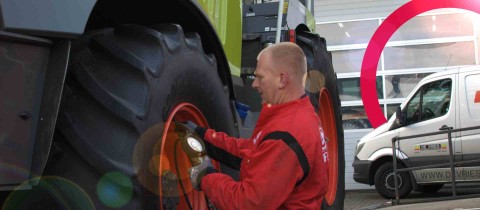The ideal tyre pressure for your tractor tyres
Three-way relationship
Standard tyres have the ideal balance between load per tyre in kg, speed in km/h and air pressure. This three-way relationship ensures ideal ease of use. If you adjust one of these factors, e.g. higher maximum speed while the load remains the same, then tyre pressure must also be adjusted. An example can be found in the table below. If you still have questions, you can always contact us for tailor-made advice!
| KM/h | 1 | 1,3 | 1,6 | 2 |
|---|---|---|---|---|
| 10 | 4820 | 5680 | 6430 | 7180 |
| 15 | 4500 | 5300 | 6000 | 6700 |
| 20 | 4500 | 5300 | 6000 | 6700 |
| 65 | 4500 | 5300 | 6000 | 6700 |
| 70 | 4100 | 4820 | 5460 | 6100 |
Prevent unnecessary wear and tear on agricultural tyres
It is important to have the right tyre pressure on and off-road so unnecessary wear and tear can be prevented in the profile and casing. Driving at low pressure and high speed results in excessive flexure in the tyre. This leads to excessive tyre pressure and excessive loads on the edge of the tyre. When working in fields, inappropriate tyre pressure can cause agricultural tyres to revolve around the rim and folds to occur in the casing. This increases wear and tear, and makes tyres less efficient.
Narrow Rim Option
IF and VF are mounted on a wider rim than standard radial tyres. Why? To increase air volume and maintain the stability of the tyre. If manufacturers develop the tyres with a Narrow Rim Option (NRO), they can be mounted on a narrower rim than recommended. This makes it easier to switch from standard tyres to IF or VF tyres and reduces total investment. An example can be found in the table below.
Please note: NRO is not available for every brand or size. To ensure tyre stability, tyres must often be used with a higher tyre pressure than one would normally use for IF and VF tyres.
Pressure control system for agricultural tyres
The tyre inflation system allows you to always maximise the potential of your tyres. You can drive on roads with high pressure and decrease it once you enter the field, increasing the contact surface and offering better protection to the soil. This system is mainly appealing for large self-driving harvesting machines, fertilisers and heavy tractors and trailers that perform a lot of combined field and transport work.
Overview of your savings
In the field, the tyre inflation system reduces fuel consumption by 7% to 10% (source: Stichting SVOB). On the road, fuel savings are determined by the situation: with only a tractor, you save 5%; with more equipment you save 12% and with a trailer you save 17%. In addition, the tyre inflation system helps to reduce tyre wear & tear by 30%. Of course, you also save time and the reduction in soil compaction helps to improve your yield by a few percent.
In short: a great investment.
Tyre pressure problems
An example is probably the best way to offer an insight into the issue of tyre pressure in the agricultural sector. Because situations vary so greatly, a single guideline does not apply to all cases. And an example can help to identify commonly encountered bottlenecks and potential solutions.
Practical tyre pressure in agricultural vehicles
Connected equipment poses a major challenge as far as tyre pressure is concerned, because that's when the biggest load changes are encountered. In certain conditions, the extra weight behind the tractor's centre of gravity serves as a lever, even though weights are used to avoid this.
Centre of gravity
For example, when a plough is connected to a tractor, there is a big difference between its horizontal position (operational) and its vertical position (during transport), like when driving on the road. The difference in speed for both positions also plays a role. This change in centre of gravity causes the tractor to tilt backwards because the rear axle becomes heavier in relation to the front axle. And this has a negative impact on control and safety when driving on the road.
Two options for tyre pressure on agricultural vehicles
Irrespective of vehicle type, tyre pressure must be adjusted to suit the maximum load. In the above-mentioned situation, pressure in the rear tyres should be doubled (on average). However, this is far from ideal when working in fields. Therefore, tyre pressure should actually be adjusted every time there is a change in surface (and speed). If this is too difficult or impossible, the best option is to select tyres with a large air chamber and the same rolling circumference. However, this option is not always possible due to the width of furrows.
Wheel load and speed
Tyre pressure is determined by the wheel load – this can be calculated on paper or via weighing – and the operating speed. The required pressure can be identified by referring to use tables provided by the tyre manufacturer. Do not use a general table or a table provided by another brand because there are sometimes major differences between the same tyres offered by different brands. The experts at Heuver will help you to find the right tyre, for the right purpose and at the right pressure.
Like to know more?
Do you need advice? Please contact us, our experts will be pleased to assist you. Contact our experts at +31 (0)523 - 850 850 or by e-mail to info@heuver.com. You can also read all about agriculture on the agricultural knowledge-page.

